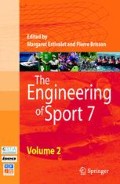Abstract
This paper outlines the use of finite element analysis to describe the heat transfer in footwear. Experiments were conducted to determine the temperature distribution in footwear with a variety of environmental temperature and footwear properties considered. Finite element models describing the heat transfer between the foot, sock and shoe are presented with the conductivity, specific heat and density properties of each material presented taken from literature. Based on foot geometry obtained from plaster casts, these models predicted temperatures within footwear with conduction, convection and radiation taken into account. Results from the models were compared with experimental findings with generally good agreement; however the models were limited by a simplified heat input value based on whole body values which did not account for the counter current heat exchange and also by the absence of evaporation as a mode of heat transfer which was significant in hotter conditions. A sensitivity analysis on the heat transfer models showed that the major contributors to the in-shoe conditions under dry heat transfer were the ambient temperature and the initial temperatures of the foot, while the heat flux and sock conductivity also had a minor affect. Further studies are required to include the effects of evaporation and to include the counter current heat exchange as a control for heat input to the foot.
Preview
Unable to display preview. Download preview PDF.
8-References
Boregowda S., Tiwari S., Chaturvedi S. Simulation of human thermoregulation using finite element method ASME Bioengineering Conference, 35, (1997), pages 83–84.
Cengel Y.A., Heat transfer: a practical approach. McGraw-Hill, New York, (1998).
Ghaddar N., Ghali K., Jones E. Integrated human-clothing system model for estimating the effect of walking on clothing insulation. International Journal of Thermal Sciences, 42, (2003), pages 605–619.
Givoni G., Belding H. The cooling efficiency of sweat evaporation. Biometeorology 20, (1962), pages 304–314.
Havenith G., Individual heat stress response. Ph.D thesis (1997).
Holman J.P., Heat transfer 9th Edition. McGraw Hill, London (2002).
Lotens W. A., Heat transfer from humans wearing clothing. Ph.D. thesis, TNO-Institute for Perception, (1992).
Lotens W. A., A simple model for foot temperature simulation. Soesterberg: TNO Institute for Perception IZF, (1989).
Lotens W. A., Heus R., Van De Linde F., A 2-node thermoregulatory model for the foot. Thermal Physiology (1989), pages 769–775.
Kuklane K., Holmer I., Havenith G., Validation of a model for prediction of skin temperatures in footwear. Journal of Physiological Anthropology 19(1) (2000), pages 29–34.
Oakley E.H.N., The design and function of military footwear: a review following experiences in the South Atlantic. Ergonomics 27 (1984), pages 631–637.
Simonson J.R., Engineering heat transfer. Macmillan Press Ltd, London (1981).
Collins K., Weiner J. The control and failure of sweating in man. Biometeorology, 18, (1962), pages 280–284.
Author information
Authors and Affiliations
Rights and permissions
Copyright information
© 2008 Springer-Verlag France, Paris
About this paper
Cite this paper
Covill, D., Guan, Z., Bailey, M., Pope, D. (2008). Finite Element Analysis of the Heat Transfer in Footwear (P186). In: The Engineering of Sport 7. Springer, Paris. https://doi.org/10.1007/978-2-287-09413-2_30
Download citation
DOI: https://doi.org/10.1007/978-2-287-09413-2_30
Publisher Name: Springer, Paris
Print ISBN: 978-2-287-09412-5
Online ISBN: 978-2-287-09413-2
eBook Packages: EngineeringEngineering (R0)

